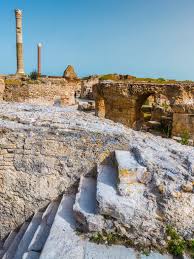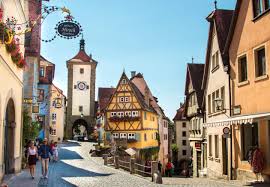Want to visit Roman ruins? This German town is a must-visit alternative

Rome: The hordes of visitors now flocking to Rome threaten to turn the Eternal City into an infernal one. The crush at the Colosseum and long snaking lines to visit the ancient monuments such as the Pantheon have overwhelmed officials who are even thinking of charging access to famous sites like the Trevi Fountain.
To find the grandeur that was ancient Rome, travelers don’t have to visit the Italian capital. Instead, they can opt for an alternative in a country not usually associated with togas and gladiators, the city of Trier in western Germany.
In classical times, parts of Germany were provinces ruled by Rome. These were no barbarian backwaters, but prosperous, developed, and populated. Strategically set on the Moselle River, Trier was often called the Second Rome or “Rome of the North” due to its size and political influence in the Empire’s later years. Between 293 and 395 A.D. the city served as the residence of several Roman emperors, including Constantine the Great as well as the Western empire’s administrative center. Trier’s ruins and monuments, part of a UNESCO World Heritage designation, can be explored mostly without rubbed shoulders or sharp elbows found at Italian sites.

“Imagine large and impressive Roman monuments but without as many tourists,” says University of Trier Junior Professor of Provincial Roman Archaeology Ferdinand Heimerl. “It’s an up-close experience.” Indeed, visitors can see builders’ marks engraved in the stone blocks of the city gate and the imprint of tools such as a long-vanished compass that fell in the wet concrete of a bath complex during its construction.
To begin their discovery of the Roman era, Dr Heimerl advises travelers to start at the Rheinisches Landesmuseum Trier. “The museum’s displays of everyday life and scale-models of the Roman city provide a good orientation for the physical monuments,” he says.
Visitors will find an extensive collection of Roman antiquities including mosaics, frescoes, and sculptures dating from the city’s foundation in 16 B.C.E. through the fall of the Western Roman Empire. The museum’s showstopper is the Trier Gold Hoard, discovered in 1993 by construction workers building a bank. This spectacular find consists of 2,650 solid gold coins—one of the largest Roman treasures uncovered anywhere.
Other noteworthy displays include the Neumagen Wine Ship—a Third Century stone relief from a Roman tomb monument depicting a barge transporting wine barrels down the Moselle River and the Trier Ceiling Frescoes—painted ceiling fragments from a villa, showcasing intricate designs and mythological scenes. They are a colorful glimpse into the opulent interior decorations of wealthy Romans.
The Porta Nigra. Constructed without mortar, and using only iron clamps to keep its massive sandstone blocks upright, the hulking Porta Nigra, or “Black Gate,” built around 170 A.D. is the best-preserved Roman city gate north of the Alps. Named after the color of its weathered stones, the gate survived thanks to Simeon, a Greek hermit who lived inside it in the 11th century. After his death, the Porta became a church, a role that stopped it from being dismantled for building materials like Trier’s other gates. Napoleon Bonaparte ordered the church demolished in the early 19th century, restoring the Porta Nigra to its original appearance.
The Imperial Baths, or Kaiserthermen, were built by the legendary Emperor Constantine I early in the 4th century A.D. Today, the impressive ruins offer a glimpse into Rome’s sophisticated engineering and feature an extensive underground network of tunnels, some of which are still accessible to visitors. Its run as a bathhouse was short, however, with construction halted in 316 A.D. (It was converted into a castle by the Middle Ages.) A second complex, the Barbara Baths, of which much less remains, was considered one of the Empire’s largest.
The Basilica of Constantine I, also known as the Aula Palatina, was a Roman palace built in the early 4th century A.D. to serve as Constantine’s throne room. At 108 feet tall, 220 feet long, and 87 feet wide, it the largest surviving rectangular single-room structure from Roman times, rivaling the Pantheon in Rome. The building is remarkable for its sheer size and well-preserved state. Damaged by bombs during World War II then meticulously restored, it serves as a Protestant church today.
Trier’s Roman Bridge, or Römerbrücke, spans the Moselle River, and is the oldest bridge in Germany still in use. Its nine original stone pillars date back to the second century A.D., though the upper part has been rebuilt twice since Roman times. The bridge was a crucial part of Trier’s infrastructure, connecting the city to important trade partners.
Trier’s Amphitheater, built in the second century A.D., could once seat up to 20,000 spectators. It was carved into the side of a hill, a common Roman practice that simplified construction. The arena hosted gladiatorial contests and animal fights and served as a center for entertainment and social gathering in the ancient city, says Dr. Ferdinand Heimerl.
“It’s now a good place to let children run and play,” he says. “And exploring the amphitheater’s underground passages, where animals and fighters were kept, offers relief from the summer’s sun.”
Lodging choices in Trier are varied but the Hotel Park Plaza, a modern property in the Old Town, distinguishes itself with rooms and public spaces celebrating the city’s Roman history and an expansive breakfast buffet stocked with local cheeses, yogurt and breads. For a traditional German meal washed down with a famed Moselle white try Wirtshaus Zur Glocke, a pub-like restaurant serving regional dishes including veal schnitzel. More modern, but thoroughly stocked with local Moselle wines is the Oeschsle Wein unf Fischhause. Patrons can sample up to 120 vintages along with fresh fish and seafood.





